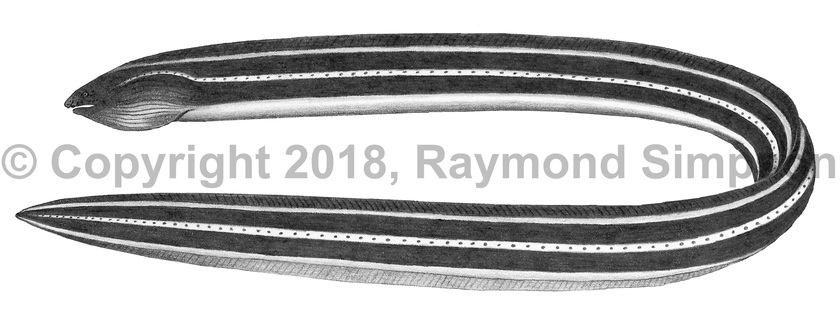
Common Name
Twostripe Snake Eel
Year Described
Kanazawa, 1952
Identification
Vertebrae: 155-167
Body moderately elongate and compressed. Trunk longer than tail (62-72% TL). Snout bluntly pointed and overhangs jaw. Anterior nostril tubular on underside of snout. Posterior nostril opens under eye on upper lip. Median groove on the underside of snout reaches to point forward of anterior nostril bases (common to all Callechelys). Teeth small and uniserial. Maxillary teeth 8-12. Dentary teeth 12-19. Vomerine teeth present. Intermaxillary teeth present. Head pores reduced to three supraorbital, two preopercular, and three supratemporal pores. Gill openings low on body and converging anteriorly. Dorsal fin origin well before gill openings, high in front, and ending before ail tip. Anal fin present. Pectoral and caudal fins absent. Tail tip hard and pointed. Lateral line complete.
Color
Distinctively black to dark gray with a white lateral stripe, white stripe at the base of the dorsal fin, and a white belly (giving the impression of three white stripes on black). Lateral pores usually darker within stripe. Head dirty whitish to gray with a broad black stripe on cheek.
Size
Reported to 172.4cm but longest verified specimens are a maximum of 87.1cm TL.
Habitat
Found in shallow coastal waters on sandy bottoms (1-22m).
Range
Insular localities from Bermuda to the Bahamas to the Caribbean Sea and the Brazilian offshore islands.
References
McCosker, J.E. 1998. A revision of the snake-eel genus Callechelys (Anguilliformes: Ophichthidae) with the description of two new Indo-Pacific species and a new Callechelyin genus. Proc. Calif. Acad. Sci. 50(7):185-215.